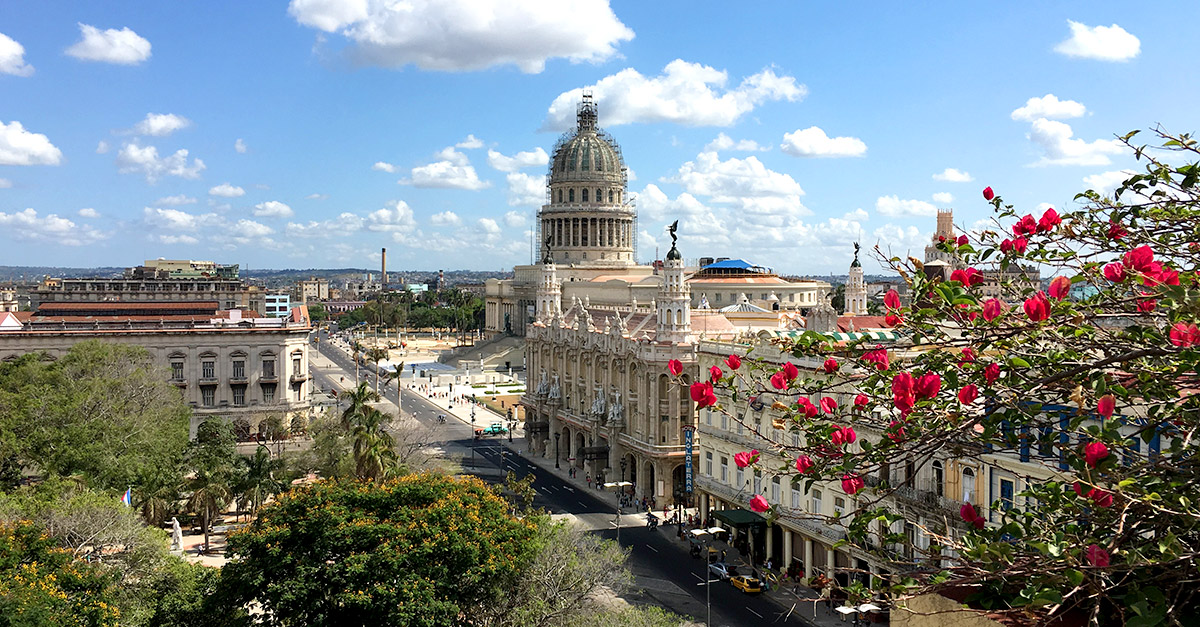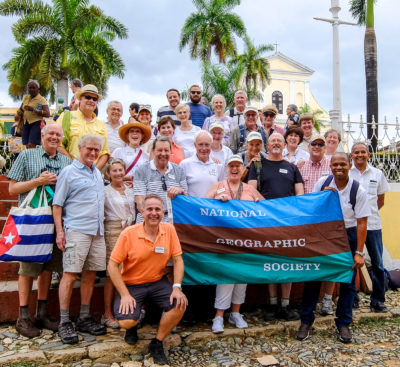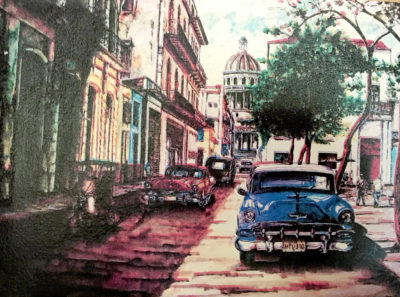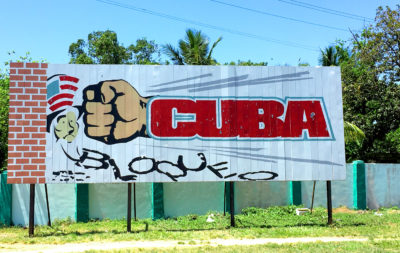
“Travel is fatal to prejudice, bigotry, and narrow-mindedness, and many of our people need it sorely on these accounts. Broad, wholesome, charitable views of men and things cannot be acquired by vegetating in one little corner of the earth all one’s lifetime.” – Mark Twain
 We just returned from an eye-opening trip to Cuba, a trip that until recently was not permitted for citizens like us. Cuba, while just 90 miles off Florida, has been off-limits to U.S. travelers for more than half a century. Traveling with National Geographic was eye-opening. Like all U.S. approved travel to Cuba, ours was a people-to-people trip.
We just returned from an eye-opening trip to Cuba, a trip that until recently was not permitted for citizens like us. Cuba, while just 90 miles off Florida, has been off-limits to U.S. travelers for more than half a century. Traveling with National Geographic was eye-opening. Like all U.S. approved travel to Cuba, ours was a people-to-people trip.
Now, as I settle back into my daily routine, I am having trouble reconciling my pre-existing prejudices with the realities of life on that small but powerful island.

Before my visit, I thought the buildings would be gray and crumbling, the people would be poor and sad, and the cars would all be old. That was okay because I wanted to see, first-hand, the devastation of almost 60 years of harsh communism. I was certain the Cubans would welcome me with open arms to fix their problems, returning them to the beautiful days of Bogie and Bacall cruising the Caribbean on their private yacht Santana with Hemingway having just one more daiquiri at the El Floridita in Havana before stumbling home to the Hotel Ambos Mundos.
After all, I assumed everything would have stopped when Fidel and his gang took over. Cuba would be in a time capsule only my USA know-how could unlock.
What I found, was a much more complex picture, with an even more complicated future.
 José Martí, a Cuban poet and patriot, admonished, “The first duty of a man is to think for himself.” That is what Cubans have done. They have survived the United States Embargo, with all its punishment on the people – not Castro’s government – and flourished in their culture of scarcity, by thinking for themselves.
José Martí, a Cuban poet and patriot, admonished, “The first duty of a man is to think for himself.” That is what Cubans have done. They have survived the United States Embargo, with all its punishment on the people – not Castro’s government – and flourished in their culture of scarcity, by thinking for themselves.
This scarcity has served them well. The Cuban people have learned to keep their fleet of 1950’s cars on the road, develop urban agriculture to provide food and enabled the government to focus on healthcare and education. What we think of as scarcity fosters sovereignty, energy independence, and sustainability for the Cuban people.
My brainwashed North American attitude, in its culture of abundance, was blown away in learning a Cuban’s life expediency was 79.1 years, higher than my 78.7 years. Also, that Cuba’s infant mortality is 5.8 per 1000 births verses our 6.2.
Fact: Cuba has enough doctors to export 46,000 to post in Latin America and the Caribbean, with a few thousand in 32 African countries. The Cuban government earns $8.2 billion from its medical workers exported overseas.
Something has been going on with this island country since we slammed the door shut in 1961. While it’s true that their infrastructure is crumbling, the Cuban creative spirit has remained alive and well. (BTW: Cuba is not the only country with crumbling infrastructure!)
Today’s Cuba is awakening to an entrepreneurial spirit that is quickly replacing government jobs where “the government pretended to pay us, and we pretended to work.”
At last count, there were over 200 permits available to small business startups for everything from event planners to pubic bathroom attendants and every possible trade.
 That entrepreneurial spirit was clearly flowing when we visited O2, a private business offering new jobs for other Cubans along with coffee, a garden, and spa. O2 has a social media presence with a website and Facebook page.
That entrepreneurial spirit was clearly flowing when we visited O2, a private business offering new jobs for other Cubans along with coffee, a garden, and spa. O2 has a social media presence with a website and Facebook page.
Like every small business owner around the world, Cuban entrepreneurs are proving how friendly, price-value services, bring in more customers with ever growing sales. One of the many home-based restaurants, called paladars, we enjoyed was La Guarida. They continue to increase in popularity and prove what great food and great service can do to make a restaurant the most desirable in all Havana.
In the end, my answer to “What’s Next for Cuba?” is that Cuba will be fine – by just being Cuba.
A culture of scarcity is different from a culture of abundance. Right? In what ways does scarcity make me stronger than abundance. Or does it?
If we all lived on an island, smaller than the state of Pennsylvania, how would we adjust? Pennsylvania has almost three times more people per square mile than Cuba (284 vs.102). Does density make life easier or harder? Why do you think so?
José Martí said, “We light the oven so that everyone may bake bread in it.” Do the words of Señor Martí speak to socialism or just an inclusive community spirit?
Have you been to Cuba? What did you think? If you would like to go someday, why do you think so?
As always, the conversation starts here.
“In the ordinary choices of every day we begin to change the direction of our lives.” – Eknath Easwaran
Epilogue
Sing along with Pete Seeger’s Guantanamera – with words that have more cultural meaning than literal meaning. This song fits the national pride of Cuba and is a symbol of peace and justice in the American folk movement.

Bruce, I visited Cuba in 2014 with the MPPC Cuba mission team and have remained very active in team activities since. The people of Cuba whom I met have been very warm and welcoming and have made it clear that they will develop and change in their own manner and what they really want from us is friendship and understanding, along with opening and expanding opportunities for exchange of goods, services and people. I will go back any time to spend more time with my Cuban brothers and sisters.
Norie –
Thanks for your comment. It is easy to want to “fix everything.” That is what we “Americans” do. But you are right, they want our friendship and understanding more than our advice.
– Bruce
Bruce, I’m so glad you got to go to Cuba at this stage. And I’m so glad that you got to see in person my observation between that the biggest asset they had to survive in an economy of scarcity is their ingenuity. For them, the definition of economics is more like: “the art and science of managing scarce and limited resources to provide for unlimited needs and wants.” And the Cubans have become masters at that. Did you notice that the police do no wear arms, just like in London or Costa Rica? I also notice that no where… Read more »
Enrique – Yes, we were fortunate to travel when we did and be able to learn so much. All of your comments are true. Your gun observation brings a story to mind. Our driver told us that he had two guns for hunting food. They are both registered with the government and he carries the permit with him. We looked at it and it shows the exact make of his rifle and shot gun. When President Obama visited he was asked to turn in his guns. He did so and they were returned when the visit was over. Ammunition is… Read more »
Bruce yes. The unification of the two currencies is the biggest challenge the are facing. And this is me talking as a (former, retired) economist. No country had unified two currencies (or two exchange rates for the same currency) without a major impact on a significant segment of its population, which suffers for at least 3-5 due to a sharp drop in purchasing parity. And the list of such countries is long, although the most commonly (and extreme) case cited is Argentina in 2002, after it operated, di facto, in several currencies for several years: at the time, 40% dropped… Read more »
Enrique –
All true, complicated by remittances, money from relatives outside Cuba, as you know, being in the Cuban convertible pesos (CUC) going mostly to Spanish-Cubans while the African-Cubans only hold the lower valued Cuban pesos (CUP).
But you are correct, enough economics for now.
– Bruce
Bruce, I so enjoyed your article on Cuba. You painted a positive picture of an area we have been led to believe is in shambles. I like the idea that just because something is outdated does not mean it is useless and should be discarded. So glad you and Joyce made this wonderful trip and shared the adventure with us
Jane
Jane –
Thanks for your comment. Yes, I am very positive on Cuba. There is still much to do and the Cuban people are up to the task. They have a wonderful tenacity.
– Bruce
Thanks for your article Bruce. We enjoyed Cuba a lot. The dedication and resilience of the Cuban people is amazing. I was struck by several things. Their dedication to education and to family for starters. Their love for music and the way they have developed of using music as a teaching tool. How it’s used in after school programs to help educate children is a model that is being copied in many central and South American Countries. Wouldn’t hurt to give it a try in the US. To talk with a man that drives a Pedi-cab 6 days a week… Read more »
Art –
Thank you for your comments. There is much to be done, for sure. As for the role of the U.S. government, I agree, until our leaders stop focusing only on special interest and being re-elected there will not be much work done.
The hope I have is in the Cuban people and the relationships they are forming with travelers from around the world.
Thanks for being part of the Choices Do Matter conversation. Please stay connected, I value your thoughts.
– Bruce
Bruce – Re Cuba, I’m still walking around the house singing Guantanamera.
One of my biggest regrets is not taking Spanish as a foreign language of choice in high school/college. However, I’m thankful for all the Latin I took – close relationship.
Jack –
I am glad you enjoyed Pete Seeger’s Guantanamera. I like it as well. Have you tried singing it in Latin?
– Bruce
I remember being in a car with the floor gone, so the road was visible. The radio was broken, so the cab driver sang to us, “Quantamera”. Of coursecitbwas about the third day by then, so we knew all the words and sang with him.
I have a few question for you. Now that Fidel died last month, what will happen with Cuba? What will happen when Raul steps down? How much do we know about the future president, come 2018, minus Raul Castro?
Definitally want to do another trip before it’s destroyed by a potential Trump Tower.
Elizabeth
Elizabeth –
That sounds like an exciting cab ride. How great that the driver made the best of it…
You are asking some vital questions on the future of Cuba. I’m not sure anyone knows those answers. Time will tell, as it does with all things, but I do feel the people are strong and resourceful. They are survivors.
My hope is for them to continue moving toward freedom.
Peace,
– Bruce